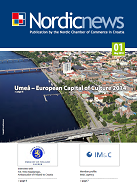Market for windpower expected to grow
More than 130 wind farms in Finland are likely to enter the wind market in near future. Wind power will produce 12% of Finland’s total electricity needs within the next twenty years, predicts the Finnish Wind Power Association.Wind power currently accounts for 0.3 per cent of the Finnish electricity supply. Now there are 130 wind farms in operation throughout Finland, but if the FWPA’s dreams come true, by 2030 there will be around 2,000 wind energy farms.
“Wind farms should be built in connection with existing built infrastructure. In that way the electricity could be transmitted straight to the user,” the FWPA’s managing director Jari Suominen said at a press briefing last week.
If wind power plants are taken into account in connection with the planning of, for example, harbours, industrial areas, and motorways, overall development of the region in question would be more efficient and the environmental impact could be minimised, says Suominen.
According to the FWPA, increases in the price of electricity and advances in wind power technology make it possible that the production of wind-generated electricity can be increased without outside support.
One example of technical advances in wind power is that wind farms are being built this year with turbines with a diameter of as much as 110 metres. This means it is no longer absolutely necessary to locate wind farms close to the coast – they can now be as much as ten kilometres inland. Within a couple of years rotors with a diameter of 120 metres will be available, making it possible to locate windmills up to 100 kilometres from the coast.
Generating power, and jobs
Professor Peter Lund of Helsinki’s Aalto University remarks that a global energy “revolution” is in the offing.
“Renewable energies and energy-efficient technologies will have pride of place. The energy and climate crises will not be resolved without an energy revolution,” he emphasises.
Lundnotes that in Germany, for one, renewable energy and wind power are part of national industrial and technology policy. It has been noticed that economic incentives such as feed-in tariffs can reduce the average price of electricity. Feed-in tariffs guarantee the producer a fixed price, independent of market fluctuations.
“Consumers benefit more when the feed-in tariff is increased,” Lund adds. In Germany, according to Lund, renewable energy sources have already increased tax income, rental income on land, and created employment, with 300,000 new jobs having been created over the past decade and a further 100,000 coming in the near future.
EEVA NIKKILÄ-KIIPULA – STT
HT
Source: News from Finland, Helsinki Times


























